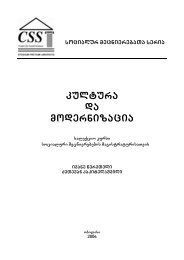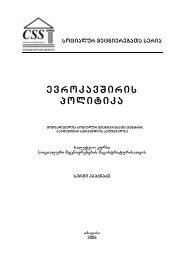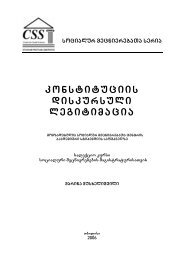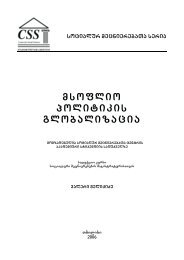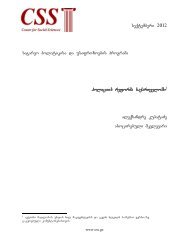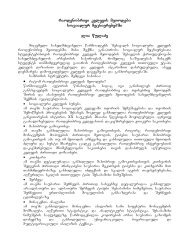Tanamedrove sazogadoeba - Center for Social Sciences
Tanamedrove sazogadoeba - Center for Social Sciences
Tanamedrove sazogadoeba - Center for Social Sciences
Create successful ePaper yourself
Turn your PDF publications into a flip-book with our unique Google optimized e-Paper software.
politics of categorical distinctions. Cultural categorization and the power of authoritative<br />
categorization are important stakes in social struggles and central to understanding of<br />
inequality and social change. Moreover, intellectuals and social scientists are not only<br />
analysts but also important participants in symbolic politics, and their work demands an ethic<br />
of reflexivity.<br />
Using the illustration of life in the modern city, George Simmel suggests here some<br />
distinctive features of culture in modern, complex societies (in contrast with the smaller, premodern<br />
societies, which anthropologists like Ruth Benedict mostly studied). In large and<br />
highly differentiated modern societies, the multiple social circles, the money economy, and<br />
the specialized division of labor lead to increasing rationalization and objectification in<br />
culture. Simmel also suggests that while the possibilities of individuality and individualism<br />
grow, individual experience becomes more shallow, and that objective cultural products<br />
multiply and come to dominate subjective meanings and values.<br />
Given the intuition that "shreds and patches" drawn from various places can be so<br />
organized into particular patterns that appear "unique" and "different" to an observer, the<br />
problem remains: how is this intuition to be grounded? Is it in fact more than an intuition to<br />
be dismissed on the basis of further analysis? Is it an "illusion" as gestalt experiments are<br />
often said to reveal? Or are we confronted here with essential aspects of all reality: mutually<br />
organized parts make new "wholes" <strong>for</strong> those who stand in particular relations to the parts.<br />
In fact, there is powerful evidence that the intuition of cultural integration that drove<br />
Benedict's work is not an illusion to be deconstructed but rather something to confront<br />
directly.<br />
Cultural Representations and Signifying Practices (Language)<br />
For many reasons, this should take us to a discussion of the importance of language in<br />
relation to culture. When we talk about culture, we refer to “shared meanings”. As <strong>for</strong> the<br />
language, it is the privileged medium in which we ‘make sense’ of things, in which meaning<br />
is produced and exchanged. Meanings can only be shared through our common access to<br />
language. So language is central to meaning and culture and has always been regarded as<br />
the key repository of cultural values and meanings. Language is also an ultimate metaphor<br />
<strong>for</strong> humanity ("In the beginning was the Word"); one the most obvious instance of human<br />
cultural activity to analyse <strong>for</strong> what it might teach us about humanity together. But how<br />
language construct meanings and how does it sustain the dialogue between participants<br />
which enables them to build up a culture of shared understandings and so interpret the world<br />
in roughly the same ways? Language is able to do this because it operates as a<br />
representational system. In language we use signs and symbols – whether they are sounds,<br />
written words, electronically produced images, musical notes, even objects – to stand <strong>for</strong> or<br />
represent to other people our concepts, ideas and feelings. Representation through<br />
language is there<strong>for</strong>e central to the processes by which meaning is produced.<br />
Language provides one general model of how culture and representation work,<br />
especially in what has come to be known as the semiotic approach – semiotics being the<br />
study or ‘science of signs’ and their general role as vehicles of meaning in culture. In more<br />
recent years, the preoccupation with meaning has taken a different turn, being more<br />
concerned, not with the detail of how ‘language’ works, but with the broader role of discourse<br />
in culture. Discourses are the way of referring to or constructing knowledge about a<br />
particular topic of practice: a cluster (or <strong>for</strong>mation) of ideas, images and practices, which<br />
provide ways of talking about, <strong>for</strong>ms of knowledge and conduct associated with, a particular<br />
topic, social activity or institutional site in society.<br />
These discursive <strong>for</strong>mations, as they are known, define what is and is not appropriate in<br />
our <strong>for</strong>mulation of, and our practices in relation to a particular subject or site of social activity;<br />
what knowledge is considered useful, relevant and ‘true’ in that context; and what sorts of<br />
persons or subjects embody its characteristics.<br />
We examine also, how representation is working in television soap opera. These are<br />
enormously popular sources of fictional narrative in modern life, circulating meanings<br />
throughout popular culture – and increasingly worldwide – which have been traditionally<br />
defined as ‘feminine’ in their appeal, reference, and mode of operation. Christine Gledhill, in<br />
Representation, Cultural Representations and Signifying Practices, unveils the way this<br />
gendered identification of a TV genre has been constructed. She considers how and why<br />
80




